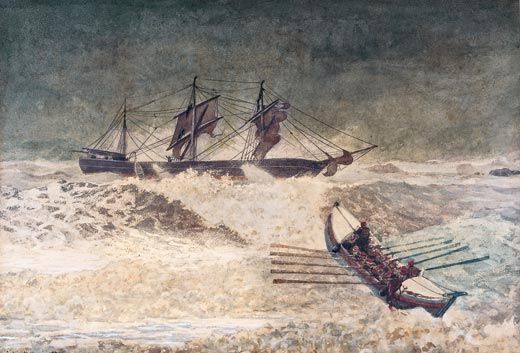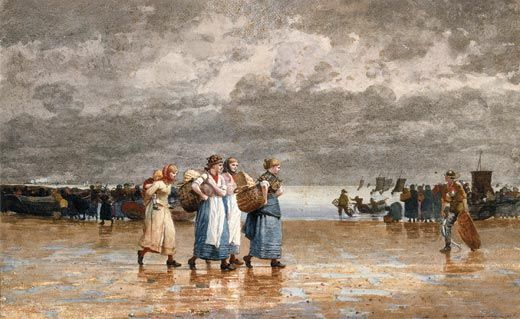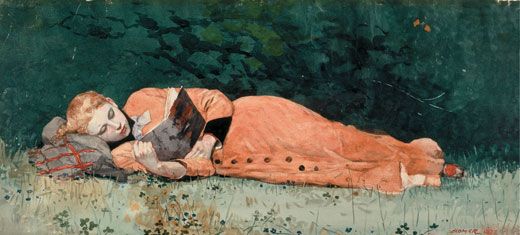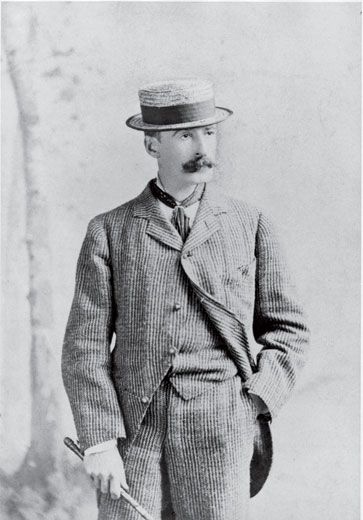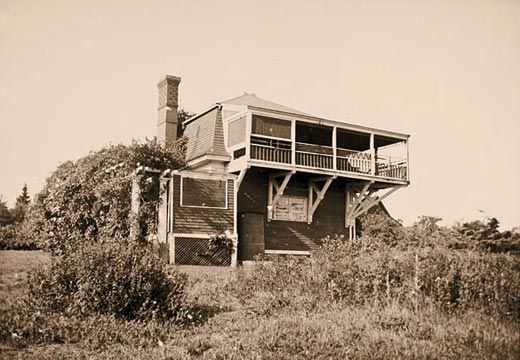Hidden Depths
Winslow Homer took watercolors to new levels. A Chicago exhibition charts the elusive New Englander’s mastery
The storm pounded in from the North Sea on October 20, 1881, picked up the Iron Crown like a toy and drove the 1,000-ton bark onto the shoals near Tynemouth, on the Northumbrian coast of England. Hundreds of villagers rushed to the Life Brigade House to launch rescue operations.
As night melted into the morning of October 21, members of the life brigade wrestled a boat into the surf and managed to bring 20 people from the Iron Crown to safety. With all but one of the ship's hands accounted for, all eyes turned back to the battered vessel. There the lonely figure of Carl Kopp, a crewman thought to have been washed overboard, appeared on deck, clinging to the ship with one hand and waving with the other. The weary life brigade took up their oars again, plunged back into the sea and brought him ashore.
As this seaside drama rushed toward its denouement, a horse-drawn cab pulled up to the wharf. A dapper little man with perfect posture and a swooping mustache emerged, made his way quietly through the crowd and staked out an observation point overlooking the harbor. Then Winslow Homer produced a pad of paper and a piece of charcoal, sat down and quickly began to sketch salient details of the scene before him—women in shawls leaning into the wind; fishermen in dripping sou'westers scrutinizing the stricken ship; rescuers rowing a lifeboat up through a mountain of water; the Iron Crown wallowing in the distant surf. Homer's view of the ship would be one of the last. Its masts collapsed. It broke into pieces and sank. "Nothing was to be seen of her afterwards," a local newspaper reported, "beyond portions of her stem and stern heaving like black shadows on the water, alternately obliterated by the lashing sea."
Homer disappeared with his sketches, returned to his studio in the fishing village of Cullercoats and set to work immortalizing the life-and-death struggle he had just witnessed. He rendered the scene in a palette of solemn gray, brown and ocher, with raging seas and menacing skies dominating the picture. As he often did, he reduced the subject to a few essentials—gone were the men and women he had sketched on shore; gone was the sturdy stone wharf underfoot; gone was any reference to land at all. Homer plunged the viewer right into the churning sea, along with the tiny humans struggling against it. What is remarkable is that he chose to produce The Wreck of the Iron Crown in watercolor, a delicate medium then generally considered to be the weapon of choice for amateur artists, at least in Homer's native America. But he seldom played by the rules.
"This resolute New Englander didn't care a fig that watercolor was an amateur's medium, taught to polite young ladies in finishing schools," says Martha Tedeschi, curator of prints and drawings at the Art Institute of Chicago, where she helped organize an exhibition of some 100 Homer watercolors and 30 associated works (through May 11). "In fact," says Tedeschi, "its marginal status quite suited him. Watercolor offered liberation from the stifling academic rules and public expectations that governed oil painting."
Age 45 when he appeared in Cullercoats, Homer was already recognized for his achievements at home, but he was clearly eager to improve his artistic reach. Most likely, he went abroad to escape the social distractions of New York City, to search for fresh subjects and to explore new ways of presenting them. This is pure speculation because the sometimes reclusive Homer was notoriously unrevealing about his personal affairs, his methods of painting and his artistic intentions. "Mind your own business!" were his four favorite words, according to a friend.
Despite this, some details of the mystery man's life are clear. Born in Boston in 1836, he learned the rudiments of watercolor from his mother, Henrietta, and a practical appreciation of business from his father, Charles Savage Homer, a hardware merchant who encouraged his son to serve an apprenticeship with a Boston lithographer. This taught Winslow drawing and led to his work as an illustrator for Harper's Weekly, for which he covered the Civil War. He produced powerful oil paintings from the conflict and its aftermath, and won critical acclaim for the originality, honesty and energy of his work. Largely self-taught, he started in 1873 to experiment in the tricky idiom of watercolor, which he would make part of his artistic language for the rest of his life. He produced some 700 known watercolors by the time of his death in 1910. His supremacy in the medium was undisputed by then, and so it remains today, as evidenced by the exhibition at the Art Institute of Chicago, the largest gathering of his watercolors in more than two decades.
Given the fragility of watercolor pigments, which fade when exposed to light, the Chicago show provides a rare opportunity to see many of Homer's works in one place, collected from private owners and museums around the country. The exhibition also tracks how the artist mastered the medium over three decades; how he used it to experiment with subjects he would enlarge upon in oils; how he incorporated a compact watercolor kit into his far-flung painting excursions; and how the medium became a ready source of income for the ever-practical Homer, who could produce watercolors more cheaply, more quickly and in greater quantity than he could bulky, slow-drying oil paintings. The show also sheds light on Homer's pioneering use of scraping, sponging, sanding, blotting and other reductive techniques to put foam in his waves, mist in his skies and a glint in the eye of an Adirondack guide.
"A much richer picture of Winslow Homer emerges from this exhibition," says the show's curator, Tedeschi. Conservators at the Institute spent part of the past two years performing technical analyses of selected Homer watercolors, scrutinizing them with microscopes, X-rays, infrared light and other diagnostic tools to unlock a few of the master's secrets. (See p. 90.) Such high-tech intrusions would no doubt have driven Homer to apoplexy, but in Tedeschi's view, the new research only heightens the artist's standing.
"It reinforces his genius," she says. "Homer has long been admired as a watercolorist capable of painting quickly to record the most immediate and ephemeral sensations. Yet, as our line of inquiry indicated, his watercolor practice was also full of experimentation—studying, reworking and planning. While part of his genius was his ability to make his watercolors look effortless, they are often the result of complex and even labored artistic planning. But he never sacrifices that feeling of immediacy. You never see all the hard work behind the images. I think that makes his achievement even more miraculous."
It seems that way when you stand before The Wreck of the Iron Crown, which Homer carefully packed and shipped home to his Boston dealer in February 1882, with a $250 price tag. The picture still radiates a feeling of tension as the Iron Crown teeters on the edge of destruction: the sand stings, the surf thunders, the black sky bears down on the ship—and all these years later, the viewer involuntarily shudders.
Homer's eerie ability to convey the mood of the moment is one of the reasons his work endures. "You feel that you're feeling what Homer wanted you to feel," says Tedeschi. "If it's a sunny meadow, you're in that sunny meadow. If it's a marine subject, you feel the sea breeze and hear the surf. I wouldn't call it realism. I'd call it a kind of veracity. Especially in his watercolors, he produces a very convincing aura, which often includes a clear sense of what the temperature is, what the air movement is like, where the light is coming from. You just let yourself feel it, which is very satisfying."
His sojourn in Cullercoats, which occupied Homer for almost two years, greatly broadened his range of expression. Once known as the chronicler of American childhood and farm life, Homer grappled with weightier concerns in England. There he began to consider the precarious place of humans in the natural order. He produced at least 55 watercolors while living on the North Sea and completed another 20 or so based on Cullercoats after his return to the United States in 1882. They were more sophisticated, more finished, more subtle and larger than anything he had attempted before. He spent hours closely observing the light and gauging the weather, made careful preliminary sketches, reworked them in his studio and sometimes finished them outdoors with a model in tow, just as the desired conditions of light, weather and atmosphere fell into place. "I would in a couple of hours, with the thing right before me, secure the truth of the whole impression," he told a friend.
Homer came to admire the hardy men and women who wrested their living from the sea, risking their lives each day. They march through his pictures with their baskets, mend their nets and converse quietly from boat to boat on calm evenings. And day after day, they look anxiously to sea under racing clouds, waiting and watching for a loved one's boat to appear. Homer celebrates the dignity of his Cullercoats subjects, the fragility of their lives and the raw power of the natural world in which they exist—themes he would explore in other settings and by other means again and again.
His English stay proved transformative, says Nicolai Cikovsky Jr., a Homer biographer and the former senior curator of American and British painting at the National Gallery of Art in Washington, D.C. "It's hard to think of such an extraordinary change in another artist. His figures become more classical, more sculptural; his subjects more heroic; his outlook more epic; his meaning more serious. The work gets physically larger." For the business-minded Homer, bigger pictures meant bigger paychecks: "I will send you some water colors—large size & price," he wrote to a Boston dealer in October 1881, two months before shipping 30 new sheets to him. "You can keep them in a portfolio or have an exhibition as you think best."
The dealer, J. Eastman Chase, quickly arranged a show for February 1882, to good reviews. Homer's new work, the Boston Evening Transcript reported, was "positively exhilarating." More shows and favorable notices followed. "Homer is both the historian and poet of the sea and sea-coast life," said one critic. The influential Mariana Griswold Van Rensselaer, writing in The Century Magazine, described Homer's Cullercoats watercolors as "not only...the most complete and beautiful things he has yet produced, but among the most interesting [that] American art has yet created."
Much to Homer's delight, the English works sold well in America, where he was soon earning as much as $250 per watercolor, up from the $50 to $75 he had commanded at the start of his career. "You will see," he confided to a friend, "in the future I will live by my watercolors." Homer's prediction proved to be prophetic on two levels: watercolors made him famous in his own time, and they paid the bills, which freed him to lavish months, even years, on such monumental oil paintings as The Fox Hunt, The Herring Net, Lost on the Grand Banks and Northeaster.
All of these oils were painted in Prout's Neck, Maine, a rocky peninsula battered by the North Atlantic and situated about ten miles south of Portland. Homer settled there in 1883, shortly after his return to the United States. He was drawn to the Maine coast for its harsh beauty, its dramatic equinoctial storms and its isolation. It was also convenient. His family had bought land and established summer homes there: Homer's parents moved in with his eldest brother, Charles, while middle brother Arthur built his own place nearby. The living arrangements soon became too crowded for Winslow, who commandeered a carriage house from one of the properties, had it moved up the shore and converted it into the plain home and studio that became the center of his world for the rest of his life. One special feature of the house was its covered balcony, "braced so as to hold a complete Sunday school picknick," in Homer's phrase. This piazza, which offered a commanding view of the ocean, became a favorite roost for Homer, who haunted it for hours on end, staring out to sea, observing the incessant war between waves and rocks, the raw material for future work.
His time in Cullercoats had taught Homer not only new ways of seeing but also new ways of living. He discovered that he worked best alone, away from the social demands of an urban environment. He felt a special affinity for the independent farmers and fishermen of Prout's Neck. They were blessedly scarce on the ground, they respected his privacy and, like him, they worked with their hands.
"All of his life Homer was attracted to working people," says Tedeschi. "He was a worker himself. He had no great pretensions about who he was or what he was. Other workers fished. He worked in paint." Indeed, in the rare instances when Homer spoke about his art, he used the language of labor: his studio was a "painting factory"; he produced not art but "goods" to be sold.
Homer's hardworking habits won the respect of his neighbors at Prout's Neck, who even came to accept his strange ways—his walking backward on the beach squinting at the sky, his pacing the balcony alone at night, his refusal to answer the door, his congenital frankness, his compulsive hoarding. He had six kerosene stoves, and he received a never-ending stream of supplies by mail—cases of fruit, barrels of cider, legs of mutton and, in one memorable shipment, 144 pairs of socks. Portland's best tailor dispatched a new pair of pants to him every month. Even on the wild coast of Maine, he remained something of a dandy, dressing sharp, decorating his lapel with a flower and bounding over the surf-lashed rocks in a tam-o'-shanter, complete with pompom. His constant companion on these excursions was a fat terrier named Sam, who came to look like a white pig as he grew older, gasping in Homer's wake. Homer slowed his pace so that Sam could catch up, which the neighbors noted approvingly.
When he painted outside, Homer made a sign to discourage inquisitive spectators: "Snakes Snakes Mice!" proclaimed the warning, planted on the beach path and aimed primarily at summer residents who lacked the circumspection of year-rounders. He slept with a pistol—this in a place where crime was virtually unknown. "I am a dead shot & should shoot, without asking any questions, if anyone was in my house after 12 at night," he declared. Nobody disturbed him.
Homer seemed to thrive in his solitude. "This is [the] only life in which I am permitted to mind my own business," he told a friend shortly after moving to Prout's Neck. "I suppose I am today the only man in New England who can do it." He elaborated in a letter to his brother Charles: "The sun will not rise, nor set, without my notice, and thanks."
Yet Homer must have been lonely when the emphatic Maine winter roared in, his relatives scattered and he faced the empty months with little human contact. He bore down on his painting, took long walks, admired the ocean storms and scribbled on the walls. He drank deeply, stopped and started again. "The trouble was I thought that for a change I would give up drinking," he joked in 1903. It was "a great mistake & although I reduced the size of my nose & improved my beauty my stomach suffered."
Given the number of handsome women who appear in Homer's work, many researchers have wondered why he remained a lifelong bachelor. He was characteristically silent on the subject, but generations of scholars have speculated, based on suggestive but inconclusive evidence, that one of his models may have broken Homer's heart, crushing his romantic ambitions and setting him to wander.
With Prout's Neck his safe harbor and home base, Homer would continue wandering for the rest of his life, gathering artistic material as he went. An avid fly fisherman, he packed off to Quebec or the Adirondacks on trouting campaigns, and to Florida, the Bahamas and other tropical locations—always with his battered watercolor kit in hand.
Like other urban refugees who ventured into the wilderness for rejuvenation, Homer came to rely upon these backwoods forays. The excursions also provided another market for his watercolors, which were snapped up by anglers, hunters and a growing community of outdoor enthusiasts. Ever conscious of commercial opportunities, Homer planned sporting vacations with them in mind.
"I send you by the American Ex. today six watercolors of fishing subjects," he announced to his New York dealer in April 1901. "They may be of interest to the fishermen now turned loose for Spring fishing. If you know any fishermen call their attention to them." Another springtime, another excursion: "As I shall go up for the Spring fishing," he reported to the same dealer in 1903, "I will take my sketch block & will give you a full line of goods for next season."
His "goods" from the North Woods Club in Essex County, New York, where Homer fished for many years, were noted for their fluidity, their understated grace and their feeling for the empty spaces—where a brook trout sails through the air to nab a fly, a majestic buck swims through an October pond, a pair of Adirondack guides drift in their boat on a perfect summer's day, masters of their environment.
Yet Homer's images are seldom as simple as they appear. His leaping trout hangs in that decisive moment between freedom and death; his North Woods guides represent a rugged individualism threatened by modern ways; his swimming buck is hounded by a hunter and his dog, almost unnoticed in the background of Homer's watercolor. Even when he was grinding out works for the hook-and-bullet set, Homer often layered his art with an element of uncertainty or irony.
"These aren't just pretty pictures," says Cikovsky. "There's always more going on in Homer's work and you have to be alert to this. He can put something almost sinister into a beautiful landscape."
Homer believed that it was the viewer's job to discern hidden layers of meaning. He never explained his intentions and became furious when anyone asked about them. "I regret very much that I have painted a picture that requires any description," he fumed when his New York dealer asked for an explanation of The Gulf Stream, the famous oil depicting a sailor adrift on stormy seas, his sloop dismasted (above right). "The subject of the picture is comprised in its title," Homer explained. "You can tell these ladies that the unfortunate Negro who now is so dazed & parboiled will be rescued & returned to his friends and home & ever after live happily."
Finished in 1899, The Gulf Stream was nearly 15 years in the making, longer than Homer devoted to any other project. This oil painting resulted from a series of watercolors Homer began in 1885, after his first visit to Florida and the Bahamas. He crossed the Gulf Stream for the first time that year and may have seen or heard about a shipwreck there. He started to elaborate upon the experience in watercolors.
The first watercolor of "The Gulf Stream" series, known as Sharks, or The Derelict, portrays an abandoned sloop with sharks circling; another called Shark Fishing, finished about the same time, introduces human interest, a pair of young Bahamian men towing a thrashing shark behind their small boat, which is dwarfed by the predator. A later watercolor, probably from 1899, shuffles these elements—the listing wreck, the black sailor sprawled wearily on deck, a mammoth shark reaching for the stern—into a design that begins to look like Homer's final vision for the oil painting. In its last iteration, he sharpens the drama: the sailor has lost his shirt and hat, a waterspout has boiled up behind him and the single shark of the last watercolor has become five sharks churning around the boat. The sailor, as if beyond caring, looks listlessly away from the sharks, which cavort through waves already flecked with red.
Although acknowledged as one of Homer's most powerful artistic statements, The Gulf Stream was not the sort of art you would hang in the living room, which may be why it sat unsold at M. Knoedler & Company in New York for several years, much to Homer's dismay. "I realize that this small business of mine is of little value to you," Homer complained to the dealer in November 1906. "You are willing to sell & I am ready to paint but I no longer paint for nothing." Homer continued fuming until December, when The Gulf Stream was shown at the National Academy of Design, bowled the judges over and was soon bought by the Metropolitan Museum of Art for $4,500—one of Homer's best payments yet. Bigger checks would follow.
Even as he aged, Homer continued to work both in watercolor and oils, each to its own purpose. The same artist who coolly summoned sharks and doom for The Gulf Stream also created luminous watercolors from the tropics, conjuring the eye-stabbing light and rustling palms of the Bahamas, the mountains of steamy cumulus piling over Key West, the crumbling languor of a hot street in Santiago—all attesting to Homer's omnivorous range, his sure grasp of optical effects and his mastery of color and light.
While his production flagged in later years, there was no sign that his powers of observation or artistic vision wavered. Even after he suffered a mild stroke in 1908, Homer quickly recovered his sight and coordination, resumed painting and tried to reassure his brother Charles by joking about it: "I can paint as well as ever," he wrote that summer. "I think my pictures better for having one eye in the pot and one eye in the chimney—a new departure in the art world."
At age 72, Homer became absorbed by a new project that kept him in Maine for the winter. "I am painting when it is light enough, on a most surprising picture," he reported to Charles in December 1908, "but the days are short and sometimes very dark." The result of this effort was indeed surprising, an oil painting entitled Right and Left. In it, he places two goldeneye ducks so prominently in the foreground that they threaten to swarm into the viewer's face. Homer catches them exactly at their moment of death, cut down by a shot-gunner in a boat, barely visible among jagged whitecaps and choppy seas. Homer's sympathy for the startled prey is obvious and in some way prescient. The painting proved to be his last major oil and his final meditation on mortality. He died of a hemorrhage at age 74 at Prout's Neck, with his brothers nearby and the sound of waves crashing outside.
Robert M. Poole is a contributing editor at Smithsonian. He has visited all of the places that inspired Winslow Homer's art.
